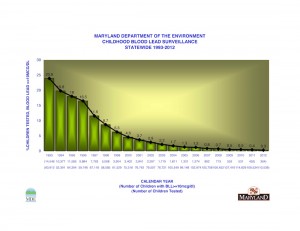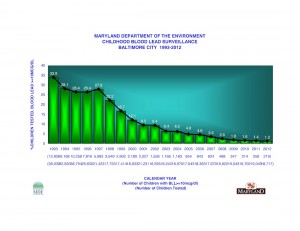Lead poisoning cases drop, many cases linked to properties not previously covered by Maryland law
Department of Environment releases 2012 Childhood Lead Registry report; continued reduction in cases shows impact of Maryland’s 1994 law; legislation addresses cases in newer rental units and owner-occupied housing
BALTIMORE, MD (September 24, 2013) – Childhood lead poisoning in Maryland continued to decrease last year, but a significant number of new lead poisoning cases are linked to homes that had not been covered by Maryland’s 1994 lead law, a report released today by the Maryland Department of the Environment shows.
Legislation passed last year is designed to reduce lead poisoning cases in homes that had not been covered under Maryland law. A key provision of that legislation takes effect in January 2015.
Statewide_2012_Childhood_Blood_Lead_Surveillance
| More Information |
| The Maryland Department of the Environment (MDE) has released the 2012 Maryland Childhood Lead Registry Annual Surveillance Report. The report shows that the percentage of tested young children with blood levels at or above the level that triggers actions under state law dropped to 0.3 percent. This is the lowest percentage ever recorded in annual surveying that began in 1993, the year before Maryland’s Reduction of Lead Risk in Housing Act was enacted. The figures also represent a decrease of more than 98 percent in the percentage of young children reported to have lead poisoning since 1993. Much of the decline in blood lead levels is the result of implementation and enforcement of Maryland’s lead law.The report also shows that more than 110,000 Maryland children were tested in 2012 – an increase from the previous year.Maryland’s 1994 lead law applies to rental units built before 1950, when lead paint was prohibited in Baltimore City. In Maryland counties outside of Baltimore City, more than eight out of 10 confirmed cases of an initial report of lead poisoning involved children living in post-1949 rental housing or owner-occupied housing. Legislation passed in the 2012 Maryland General Assembly session and signed into law by Governor Martin O’Malley is designed to reduce the risk of lead poisoning in these newer rental units and in owner-occupied properties. |
| Core Facts |
MDE’s Lead Poisoning Prevention Program serves as the coordinating agency of statewide efforts to eliminate childhood lead poisoning.Exposure to lead is the most significant and widespread environmental hazard for children in Maryland, and, according to the CDC, there is no safe level of blood lead. Children are at the greatest risk from birth to age six while their neurological systems are being developed. Exposure to lead can cause long-term neurological damage that may be associated with learning and behavioral problems and with decreased intelligence.Among other data, the annual Childhood Lead Registry survey compiles all blood lead tests done on Maryland children up to 18 years of age, and provides blood lead test results to local health departments as needed for case management and planning. Only the data for children under the age of 6 years is used for review of the lead poisoning prevention effort. MDE has compiled this comprehensive assessment on statewide childhood blood lead screening since 1993.Key statistics from the 2012 Childhood Lead Registry annual survey include:
The legislation also allows MDE to seek delegation to administer a U.S. Environmental Protection Agency rule that regulates renovations, repairs and painting in homes that were built before 1978, whether they are rental units or owner-occupied, and in pre-1978 facilities with young children. The rule requires contractors who do work on these properties to receive training and use safe work practices. Maryland regulations to allow MDE to administer the federal rule are being drafted. The U.S. Centers for Disease Control and Prevention (CDC) had, since 1990, maintained the blood lead level of 10 mg/dL as the “level of concern.” In 2012, the CDC adopted its Advisory Committee on Childhood Lead Poisoning Prevention’s recommendation that eliminated the term “level of concern” (since there is no known safe blood lead level) and the recommendation of a new blood lead level “reference level” of 5 mg/dL, based on current lead levels in the population. In 2012, 1,792 Maryland children were identified with a first-time blood lead level in the range of 5 to 9 mg/dL, compared to 2,129 in 2011. MDE, in addition to performing environmental investigations in all cases where blood lead levels are 10 mg/dL or greater has begun opening compliance cases on confirmed levels of 5-9 mg/dL in which a child is identified to live in a pre-1950 rental property. The Department of Health and Mental Hygiene (DHMH) has provided guidance to health care providers that children with confirmed levels of 5-9 mg/dL should be retested within three months, in order to ensure that their lead levels are not increasing. DHMH and MDE are also using data from the new MDE report to revise the State’s requirements for testing of children who live in certain zip codes. DHMH expects to have a draft of the revised testing strategy available for public review in several months. |
| Quotes |
| “Through Maryland’s highly successful lead program we have reduced lead poisoning by more than 98 percent. But this disease is completely preventable. We cannot and will not let up in our work to eliminate childhood lead poisoning in our state.”“Working with our partners, including Baltimore City and the Green & Healthy Homes Initiative, Maryland has made significant gains to protect our children, particularly those who live in older rental housing. But a significant number of lead poisoning cases in Maryland are linked to newer rental and owner-occupied housing. Legislation passed and signed into law last year will allow us to reach more children who might be affected by lead paint dust – and allow us to prevent more children from being poisoned in the first place.”— Robert M. Summers, Secretary, Maryland Department of the Environment “Lead poisoning can rob children of their potential. Maryland has made tremendous progress over the past two decades, but there is still work to do. We must partner with health care providers to ensure that children are appropriately screened and tested around the State, build on efforts to reduce lead exposure from contaminated housing and help parents prevent low-level exposures from other lead sources. The Maryland Department of Health and Mental Hygiene will continue to work with MDE and our partners to eliminate lead poisoning in Maryland.”— Dr. Joshua M. Sharfstein, Secretary, Maryland Department of Health and Mental Hygiene “We are heartened to see the ongoing progress being made in the reduction of childhood lead poisoning in Maryland,” said Ruth Ann Norton, executive director of the Green & Healthy Homes Initiative. “We will continue to work closely with MDE on efforts to eliminate this tragic and costly disease and ensure that all of the state’s children are able to grow and thrive in safe and healthy homes.”— Ruth Ann Norton, Executive Director of the Green & Healthy Homes Initiative (formerly the Coalition to End Childhood Lead Poisoning) |


